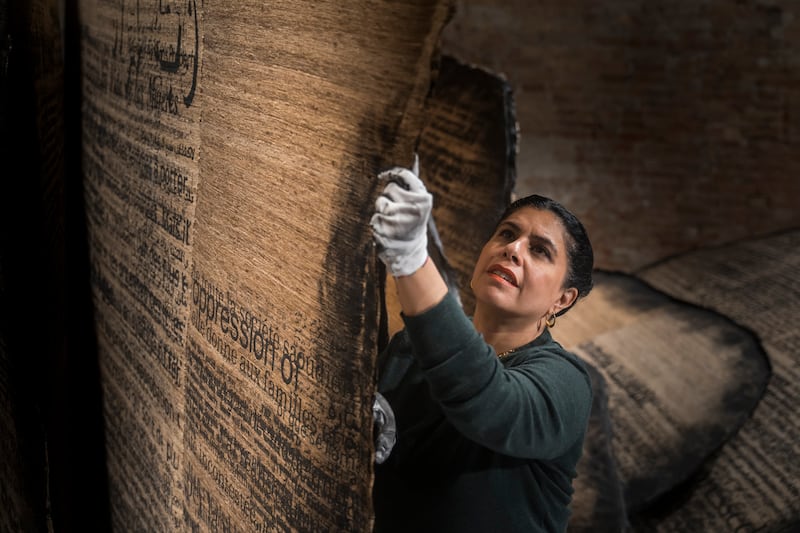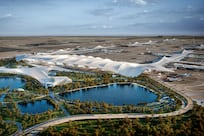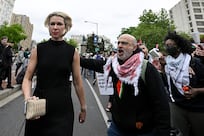Saudi visual artist Manal Al Dowayan is known for her research-based, participatory practice, placing community voices at the forefront of her artwork. Her exhibition for the National Pavilion of Saudi Arabia at this year’s Venice Biennale is no different.
Titled Shifting Sands: A Battle Song, curated by Jessica Cerasi and Maya El Khalil, Al Dowayan’s multimedia installation is inspired by the evolving role of women in Saudi Arabia. It is rooted in three workshops that took place across the country, where she engaged with more than 1000 women from all walks of life.
The installation’s genesis stems from Saudi folkloric battle songs – specifically Al Daha and Ardah – traditionally performed by men, originating before the formation of Saudi Arabia, when tribes gathered before a battle to chant poems for courage and strength.
“I always say that art sits in between the archive and the research. Continuing research is something that takes time and energy from many people to be verified,” Al Dowayan tells The National. “I can take a bit of what exists as clean truth, look at what kind of ideas are being explored and then reimagine something – trigger an idea, have a conversation in a much safer space, because the space of art is a space of imagination, of freedom, emotion, truth and humanity.
“[I explore] this idea of creating a song for women during this moment of change,” she adds. “Although women do have a lot of folkloric and traditional dances, they've never been archived or documented, so I don't know the words of the songs and the feeling of preparing as a group to make a gesture, a sound or a sonic communication.”
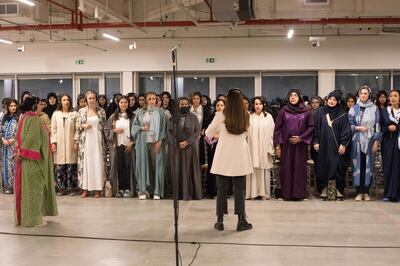
The workshops, held earlier this year in Jeddah, Al Khobar and Riyadh, form the basis of this new battle song. By open invitation, women participated in group-singing sessions led by Al Dowayan and Ileana Yasmin, a vocal coach for the Music Commission under the Ministry of Culture in Riyadh.
The women produced writings and illustrations on the topic, which are used in the installation. They were also encouraged to reflect on global media’s role in depicting Saudi women, often skewed by western politics and misinformation, rarely giving them a chance to speak for themselves.
Before the workshops, Al Dowayan took a trip to Saudi’s Empty Quarter – a vast section of desert with no human settlements – to capture the sound of the booming dunes, a humming created when the granules of sand move. She recorded the sound and played it to the women during the singing sessions.
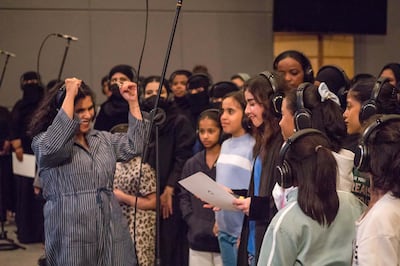
“Media today, both local and western, has been obsessed with the Arab woman, the Muslim woman, the body of the woman. The language that exists out there defining what the Arab woman is, what the Muslim woman is, is very distorted and comes from one point of view, which is 'the other',” Al Dowayan explains. “We started off the workshops with me showing articles to the women of what has been written about Arab women, then I requested they draw or write a statement about what they read.
“Then we did the singing sessions and I told the women to harmonise with the sound of the dunes. This closeness to Earth was a very important element for me and I told them to first of all hum and harmonise, then with open mouth for an 'ahh' sound,” she says. “For the third round I collected all the drawings they did, chose a set of six from every city and asked the person who wrote that text to read it into the microphone, and all the women to repeat it.”
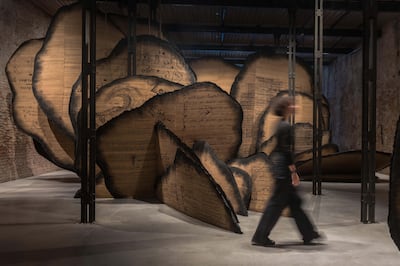
Recordings from the sessions are the first thing visitors hear when entering the pavilion, as speakers lining the hall emit the humming of the women, rising and falling with the occasional spoken word layered in.
At the heart of the installation, are four colossal sculptures based on the shape of Desert Rose crystals – naturally occurring crystals formed when heavy rain is followed by extreme dryness in the desert. The shapes, almost reminiscent of desert dunes themselves, have been made from silkscreened illustrations and writings, padded to form 3D slates, arrayed like the crystal.
Using the Desert Rose as a symbol of resilience and transformation under pressure, Al Dowayan has employed the shape in previous projects, with the largest version to date created for Venice.
“I started looking at these [now decommissioned] traditional religious instructional books from the 1990s, written by men for women, to tell them how to use their body, how to behave, the rules of the public space,” Al Dowayan says. “Always on the covers of these books you would see a women being represented as a western species of rose, as a visual language.
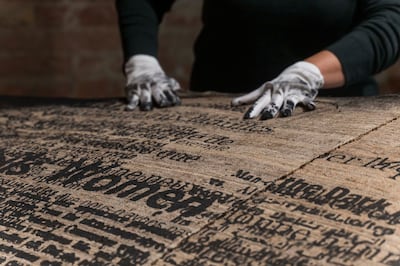
“I don't see it in my community or growing in Saudi Arabia. It's also a plucked, delicate rose that's alone, not rooted to nature, waiting to be given water and it can die at any moment. It is very delicate and weak,” she adds. “At the same time, I grew up in Dhahran, an oil community, and my family are in oil, so I was surrounded by geologists.
“Just 15 minutes away from my mother's house is a desert that produces Desert Rose crystals, and I've been playing with these since childhood. I feel that the Arab woman is closer to this story than the delicate just plucked rose on those books.”
Two sculptures act as bookends to two central ones. Words from news articles are printed on them – such as “oppressed, repressed and depressed” – removing their power. They prompt viewers to think critically of media and how specific words and images can have an impact on broader society. As such, the articles have been printed over each other in different languages, purposely illegible in some places to represent the mass of incoherent sensationalism.
The central sculptures act as the response of the Saudi women who participated in the project, with a selection of their drawings printed on the sculpture, refuting the claims and giving their own views.
“The whole exercise was meant to encourage women to look within, for energy, for power and strength; to not search for validation in the outside cacophony of people who are trying to speak on our behalf, without ever reaching out to us for our voice,” Al Dowayan shares. “We will therefore send out our voice for the next moment that's approaching us as Saudi women, because really, we've received so much change and there will be more to come.”
Shifting Sands: A Battle Song will be on view from Saturday until 24 November 2024 at the National Pavilion of Saudi Arabia at the Arsenale, Sale d’Armi, Venice, Italy.
